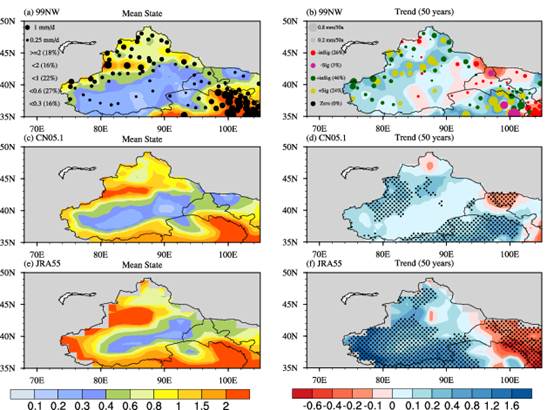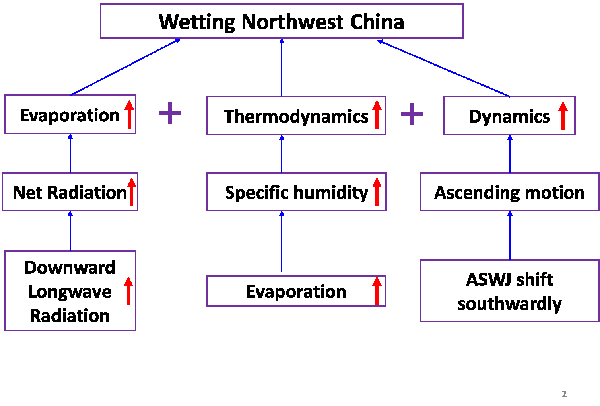State Key Laboratory of Numerical Modeling for Atmospheric Sciences and
Geophysical Fluid Dynamics (LASG)
Institute of Atmospheric Physics, Chinese Academy of Sciences

Vol. 4/No.4 December 2017
[Climate Dynamics] Why was the arid and semiarid Northwest China getting wetter in the recent decades?
Highlights:
The contribution of increased specific humidity is the dominant factor for the wetting trend.
The increasing specific humidity is associated with the enhanced evaporation which is favored by increased downward longwave radiation.
The anomalous ascending motion induced by southward displacement of Asian subtropical westerly jet also contributes to the wetting trend.
Located at the inner land of Eurasian, the Northwest China is a key component of the Silk Road Economic Belt. However, far from ocean and lies in the shadow of Tibetan Plateau, this region is one of the most arid regions in the mid-latitudes owing to the scarce water source, which results in a great challenge in the ecosystem and development of society. Many studies have shown that the Northwest China has experienced a significant wetting trend, but the reasons remain ambiguous: (1) What are the contributions of different water vapor budget terms to this wetting trends? (2) What are the mechanisms responsible for the changes of water vapor budget?
Recently, Dr. Dongdong Peng and Prof. Tianjun Zhou from the Institute of Atmospheric Physics, Chinese Academy of Sciences investigated the wetting trend in Northwest China. Based on multi-observations, they show that the summer precipitation in Northwest China has increased significantly since 1961 and the increasing trend is mainly located in western Northwest China (Fig. 1). Furthermore, the results derived from moisture budget analysis suggest that both thermodynamic (changes in specific humidity) and dynamic (changes in atmospheric circulation) components have contributed to this wetting trend, with a larger contribution from the former (Fig. 2). On the one hand, the net surface radiation increases in association with the increased downward longwave radiation, which favors evaporation and increases the atmospheric moisture content, resulting in the wetting trend. On the other hand, the horizontal vorticity advection over Northwest China intensifies in association with the significant southward displacement of Asian subtropical westerly jet, inducing anomalous ascending motion and favoring more summer precipitation.
This study clearly shows the moisture budget processes associated with the wetting trend. Most importantly, the separation of dynamic and thermodynamic components can help us better understand the corresponding physical mechanisms. However, much studies are still needed to completely address the precipitation changes in Northwest China. A great challenge in the climate change study over northwest China is the shortage of systematic and reliable long-time recorded datasets. Thus we should study the precipitation changes in Northwest China from a broader view by strengthening the cooperation with the countries in Central Asia to share the available datasets. Besides, lots of climate model simulations would be employed in examining the relative contribution of natural internal variability and human influence in the precipitation changes.
This work is recently published in J. Geophys. Res. Atmos..
Keywords Arid and semiarid Northwest China, Wetting trend, Moisture budget
Citation:
Peng, D., and T. Zhou (2017), Why was the arid and semiarid northwest China getting wetter in the recent decades?, J. Geophys. Res. Atmos., 122, doi:10.1002/2016JD026424. http://onlinelibrary.wiley.com/doi/10.1002/2016JD026424/full
Figure caption:

Figure 1 Distribution of June-July-August (JJA) mean (left column; shading, mm day-1) and trend (right column; shading, mm day-1 50 years-1) of precipitation over Northwest China (NW). Figures in upper, middle and lower rows indicate the results from 99 stations in NW (hereafter, 99NW), CN05.1, and JRA55 respectively.

Figure 2 A schematic diagram summarizing the main mechanisms in association with the increasing precipitation in Northwest China from the perspective of moisture budget analysis.
E-mail: lasg_newsletter@lasg.iap.ac.cn
Editors: Chuanyi Wang (wangcy@lasg.iap.ac.cn), Kangjun Chen(ckj@lasg.iap.ac.cn)